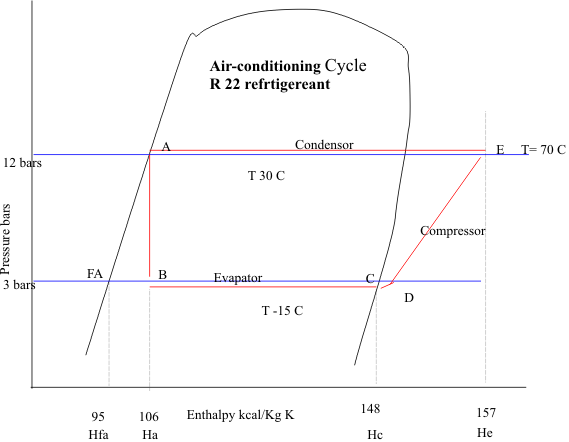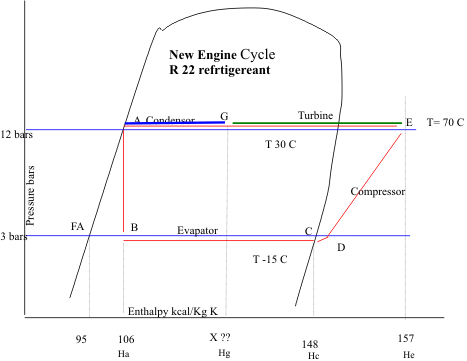A Normal Air Conditioning System Cycle.
© 2005 david graham

Figure 1 carnotcycle33.gif
In a normal R22 air conditioning system the latent heat of evaporation is about 217 kJ/kg or 52 kcal/kg, reference "Modern Refrigeration and Air Conditioning" by Althouse, Turnquest and Bracciano 18th Edition page 345. This is from point, FA to point C. In the refrigeration cycle the heat absorbed from the cycle is about (148 - 106) = 42 kcal/ kg = 176 kJ/kg, from point A to point C. The power consumed by the Compressor is from point D to point E which is 9 kcal/kg, (157 - 148). Point C to point D is heat added by superheating the refrigerant. Point E to point A is heat extracted by the condenser.
Add A Turbine To Extract Power
Consider a hypothetical turbine is added to extract power. The turbine acts as a heat sink. The cycle is as follows.
Figure 2 carnotcycle331.gif
In this engine the evaporation cycle and the compression cycle are the same. Before the heat is rejected in the condenser, a turbine is added to extract power. The power the turbine extracts is from point E to point G = (he - hg). The amount of heat that is extracted by the turbine to produce power is the critical factor. If the power out is greater than the power required by the compressor then we have a free running engine. More specifically we have an air-conditioning system that consumes no power. Consider that in the US in the summer the greatest consumer of electricity is air conditioning. This alone has potential to save considerable amounts of carbon generated electric power.
Let us assume that a wet vapor turbine can be found or developed that is able to extract say 60% of the available heat between the compressor output and the expansion valve. The remaining 40% is rejected to the air, via the condenser. This will create a power out of 0.6(he - ha) or (157 -106) * 0.6 = 30.6 kcal/kg or 128 kJ/kg. The compressor requires 9 kcal/kg or 37.8 kJ/kg to run leaving a net power out of 93 kJ/kg. This is a respectable engine.
The engine's efficiency can easily be measured. Efficiency = net Power out / gross Heat in.
Net Power = W turbine - W compressor
Net Power = (he - hg) - (he - hc) = hc - hg.
Heat in = hc - ha.
Engine Efficiency = (hc - hg)/(hc - ha) = (148 - x) / (148 - 106)
OR
Net Power = Q in - Q out
Net Power = ( hc - ha) - (hg - ha) = hc - ha. Same as above.
An Unusual Reverse Carnot cycle
This obviously is not a simple reverse Carnot cycle. This engine cannot be modeled on the reverse Carnot cycle because the Turbine is a part of the heat sink which decreases the heat rejected. One has to go to first principles to calculate it's efficiency. To better understand what is happening, let us reconsider the reverse Carnot cycle.

Figure 3 carnotcycle332.gif
As you can see from this diagram the Turbine being a wet vapor turbine operates at constant temperature, T1, and constant pressure, and is therefor part of the heat sink. Under these conditions the reverse Carnot cycle does not apply and we have to go back to basic principles.
Seldom does one defined the efficiency of a reverse Carnot cycle or cold engine. In the reverse Carnot cycle there are two efficiencies, one for a refrigeration system and a second for a heat pump.
Efficiency of refrigeration system. = T1 / ( T2 - T1 )
Efficiency of heat pump. = T2 / ( T2 - T1 )
As you can see both of these numbers will be greater than 1, usually 3 to 6. In fact both of these cold engines amplify the heat or power in. Now compare this to a normal Heat engine.
Efficiency of a normal Carnot heat Engine = ( T2 - T1 ) / T2 = 1 - T1 / T2
As you can see the efficiency of a Carnot heat engine is always less than 1.0, generally 0.3 to 0.4. Only cold engines amplify the energy in. So how do you tell the difference between a heat engine and a cold engine? Generally a heat engine has a clockwise flow on a p v , t s or p h diagram, while a cold engine has a counterclockwise flow on a p v , t s or p h diagram. This criteria does not always hold up. A better criteria is that a heat engine uses high grade heat, combustion, while a cold engine uses low grade heat, evaporation or condensation.
In the case of this hypothetical turbine the area ECFH represents the heat rejected. The work out is area BEHG. These two areas equal the heat rejected in a reverse Carnot cycle area BCFG. In this case the turbine is an integral part of the heat sink.
In this hypothetical turbine the heat added is the area ADFG and the heat ejected is the area ECFH. The net work is equal to the heat in minus heat out.
Work (net) = Q in - Q out.
Q in = T1 ( S2 - S1)
Q out = T2 (S3 - S1)
W (net) = Q1 - Q2 = T1 ( S2 - S1) - T2 (S3 - S1)
W (net) = Q1 - Q2 = S1 (T2 -T1) + T1 S2 - T2 S3
Using the new definition of reverse direction Carnot Efficiency we get.
Efficiency = Net work / Heat out
Efficiency = T1 ( S2 - S1) - T2 (S3 - S1) / T2(S2 - S1) = T1/T2 - (S3 - S1)/(S2 - S1)
The question arises at what level of efficiency would we need to get a free running engine, neglecting friction and other losses. Here the power out will match the compressor power in.
Free Running Engine Net Work = 0.
Net Work = Q in - Q out = 0.
W (net) = 0 = Q1 - Q2 = T1 ( S2 - S1) - T2 (S3 - S1)
T1 ( S2 - S1) = T2 (S3 - S1)
S3 - S1 = (T1 / T2) * ( S2 - S1)
S3 = S1 + [(T1 / T2) * ( S2 - S1) ]
Obviously a zero for Net Work does not allow for a useful calculation. Therefor we will define Wet Efficiency as follows.
Wet Efficiency = Gross Work out divided by Gross Heat to be rejected.
In the case of a reverse Carnot engine we have:
Gross Work = T2 * (S2 - S3)
Gross Heat = T2 * ( S2 - S1)
Wet Efficiency = (S2 - S3) / (S2 - S1)
If we calculate the value where Net Work = 0 from the R 22 refrigeration system Figure 2, we get.
Net Work = W out - W in.= 0.
Net Work = (he - hg) - (he - hc) = hc - hg. = 0.
hg = hc.
Wet Efficiency = Gross Work out divided by Gross Heat to reject
Gross Work out = (he- hg)
Gross Heat to reject = (he - ha)
Wet Efficiency = ( he - hg) / (he - ha)
When Net Work = 0 ; hg = hc.
Wet Efficiency = (he - hc) / (he -ha)
Wet Efficiency = (157 - 148) / (157- 106) = 18%
A Hypothetical Cold Engine a Reality
In simple terms if we can create a wet vapor turbine that can extract 18% of the heat available, into power, we have a free running engine. If we can extract 35% of the heat into power we have a multi purpose Engine. An Engine, that consumes no fuel, produces no pollution, and cools the environment.
In fact there is no such turbine that will make a line on the temperature entropy chart like BE. Most engineers would wont to place the turbine in line CD. This is a real possibility although it is not located where the greatest excess heat is available. The point of this exercise is to point out that a refrigeration system is an amplifier of energy and that there is considerable energy available that if properly taped will make a viable self sustaining hypothetical cold engine a reality for an ingenious inventor. Such an engine has unlimited potential.
This paragraph added in 2009.
I have devised a version of a refrigeration cycle that is viable and will produce considerable power. Although I have no intention of sharing the specific cycle I plan to employ, I am looking for investors who will help me build a cold engine that will produce about 200 kilowatts of power. If this venture interests you please call David at 780 450 2574. My cold engine will consume no fuel, produce no pollution, and will exhaust cool air into the environment. This is a once in a lifetime opportunity to participate in an engine that will solve the problems that man has created by powering our society with heat engines. Also this is a viable engine that eventually will replace most of the world's heat engines in the next 50 years.
Invest in a green future and reap the financial rewards of an engine that has no fuel cost.
Phone 780 450 2574
David Graham , B. Sc. Eng, P. E. T.
